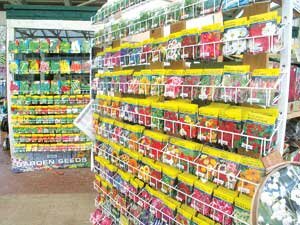Save money by growing your own vegetables
April 30, 2009
By Contributor
Can planting a veggie patch really save you money? Government agencies and gardening organizations say yes.
Every $100 spent on vegetable gardening yields $1,000 to $1,700 worth of produce, the U.S. Department of Agriculture estimates.

Squak Mountain Greenhouses and Nursery has large shelves dedicated to displaying seed packages for the home garden. By David Hayes
You’ll get a half-pound of edibles from every square foot of ground devoted to backyard crops, according to the National Gardening Association. Even a modest garden (15-by-15) can produce more than 100 pounds of garden-fresh tomatoes, salad greens, vegetables and herbs. Better flavor and bragging rights come with the harvest.
Planting a vegetable plot and keeping it productive isn’t that hard if you start small, keep the basics in mind and plant reliable varieties. Take it step by step:
Lead with location — A sunny, well-drained spot close to a water spigot is ideal. Leafy greens tolerate some shade, but other crops want eight hours of sun daily.
Suitable soil — Adding organic material is the key to an easy-care garden. It loosens stiff soil, helps retain moisture and nourishes important soil organisms. Good “ingredients” include manure, humus and chopped-up leaves. Spread a 4-inch layer of amendments on your plot and till into the top 9 inches to 12 inches.
Fertilize faithfully — All edible plants remove some nutrients from the soil, and can quickly exhaust the soil without the help of a fertilizer. Always follow the rates given on the label when deciding how much to use.
Water wisely — One inch of water weekly is adequate for most vegetables. Soaker hoses or drip systems deliver water efficiently and keep foliage dry, fending off leaf diseases.
Patrol for pests — Monitor insect damage but try to keep your crops pesticide-free. Hand-pick pests or dislodge them with a jet of water, then let natural predators do the rest. If you must spray, do it late in the day, when beneficial insects are less active.
Pick the right plants — Flower gardeners gravitate to the newest, showiest varieties, but smart food gardeners appreciate the tried-and-true. For best results, you’ll need to choose veggie and herb varieties suitable to your geographical location.
Bonnie Plants come in eco-friendly biodegradable pots that not only keep tons of plastic pots from ending up
in landfills, but also reduce transplant shock. Just tear off the bottom, set the pot in the ground and water.
If you’re ready to try your hand at creating your own backyard grocery garden, here are 10 easy crops to plant:
- Basil — Perfect with tomatoes.
- Beans — Bush beans are easier to pick, but tall “pole” beans have higher yields.
- Bell peppers — Harvest green or red, when vitamin levels are higher.
- Chard — This leafy green tolerates cool temperatures well. Some varieties have brilliantly colored stems.
- Cucumber — Plant after the weather warms.
- Eggplant — A much-loved favorite, eggplant thrives in hot weather.
- Lettuce — Go for easy “leaf” lettuces, like butter or romaine.
- Parsley — Pick curly types or flat Italian parsley. This herb is rich in vitamins and is a breath-sweetener, too.
- Summer squash — Squash are very productive plants and easy to grow. Try zucchini or yellow crook-necked squash.
- Tomatoes — These crimson favorites are the most popular backyard vegetable. Choose disease-resistant types or the extra-easy cherry tomato.
Source: ARA Content
Comments
Got something to say?
Before you comment, please note:
- These comments are moderated.
- Comments should be relevant to the topic at hand and contribute to its discussion.
- Personal attacks and/or excessive profanity will not be tolerated and such comments will not be approved.
- This is not your personal chat room or forum, so please stay on topic.


